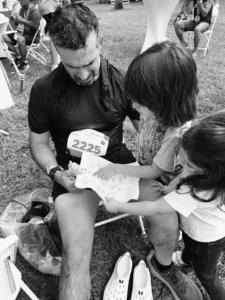My legs screamed in protest as I stepped out of the finish area, each step a reminder of the brutal toll the marathon had taken. The five blocks to my car stretched before me like an impossible journey. Just standing took effort. Every movement reminded me of the damage—the lingering injury in my left leg, made worse by the marathon, and a fresh one in my right foot from compensating during the race. Humbled and exhausted, I forced myself forward. As I approached the finish line, I saw other athletes making their final sprints, some in tears, overcome with emotion. Completing a marathon—the grueling 26.2-mile battle—has been, for many, one of the hardest things they had ever done.
I’ve been running since I was 17. No real reason, no structured training plan—one day, I just felt the urge, put on an old pair of New Balance shoes, and ran. I never stopped. Six to seven days a week, through every season and in every country I’ve traveled to, whether in scorching heat, storms, or freezing cold, running was a constant. But it wasn’t until I turned 43, with a four-year-old and a one-year-old at home, that I truly understood why I ran. It was no longer just about fitness, habit, or personal satisfaction—it became a testament to resilience, a living example for my children. I wanted them to see, learn, and understand that discipline, endurance, and commitment are not just words but actions lived out daily.
As a father, I believe in showing, not just telling. Kids might not understand the complexities of work or why their parents leave early and come home late, but they do understand a race. A marathon—simple, raw, and undeniably tough—is something even a child can grasp. They see the struggle, the sweat, the perseverance, and, ultimately, the triumph. And what better lesson to teach them than the value of commitment and endurance?
Two weeks before race day, overtraining and illness left me injured. The day before the marathon, I debated pulling out. I knew the cost—I’d be far worse off after. When you’re injured but technically capable of racing, the safest choice is not to run. It’s easy to justify stepping back. But when you’ve made a promise, and your loved ones are watching, the equation changes. Plus, then I saw my son’s excitement, his anticipation of watching his dad run “the big race.” Knowing how much this meant, even my wife told me I couldn’t back down. So I didn’t.
At mile 18, I hit the wall hard. After the heat, four rounds of puking, my left leg in massive pain, and my right foot with a new injury to compensate for the left side, it was no fun. While I knew I was not going to quit so close to the finish line, those last miles of walking and running were excruciating. What kept me running were two things: I’m not one to quit, especially so close to the end, but most importantly, I promised myself that one of the two outcomes was going to happen: Either my son was going to watch me cross that finish line, or he was going to see me carried out on a stretcher. There was no in-between. And yes, I shared this with my wife before the race. There was no way I was going to allow myself not to finish that race because my son was there witnessing his father do a hard thing, and alas, this became a two-way street in such that as I promised him I would finish it, he kept me accountable.
Crossing that finish line, I felt every fiber of my body screaming in protest, my breath ragged, and my vision blurred from exhaustion. My legs wobbled beneath me as I forced one foot in front of the other, the ache radiating through my bones. And then, through the fatigue, I saw them—my family, their faces alight with pride. My children ran toward me, arms wide, their laughter cutting through the pain like a burst of fresh air. In that moment, the agony faded, replaced by something far deeper: the overwhelming relief and joy of knowing it had all been worth it. My children ran up to me, hugging me, presenting a drawing they had made that morning as a surprise. That moment—21 weeks of work, pain, and sacrifice—culminated in something far more meaningful than a medal. It left a mark on them. Now, my son dresses like I do when I run. Every day, he goes to the patio to “train.” He insists on taking a running water bottle to school instead of his regular one. He sees. He learns.
For me, running doesn’t pay; I’m the farthest thing from a professional athlete. It doesn’t bring material rewards. There are no sponsorships, no prize money—just me, my goals, and the lessons I want to pass on. And that’s precisely the point. The true rewards are intangible—the discipline forged through repetition, the mental resilience built mile by mile, the quiet satisfaction of pushing past pain and self-doubt. These are the lessons that shape character, lessons that money can’t buy, and that’s why they matter more than anything material ever could. The hardest things in life that demand discipline, endurance, and sacrifice often don’t. In my opinion, this is something most people will never understand. But I want my kids to see differently.
Whatever your version of hard is—running, building a business, pushing through failures—let your kids witness it. Let them see what commitment truly looks like. Show them what it looks like to commit to something that won’t pat you on the back, won’t make you rich, and won’t even guarantee success. Do the hard thing anyway. Show your kids what it means to commit, to endure, to persist even when there’s no immediate reward. I remember my son gripping my medal with wide eyes, asking, “Did it hurt?” I smiled and said, “A lot.” But that’s exactly why it mattered. And don’t be the parent who just watches from the sidelines—be the one who sets the example they’ll carry for life.

